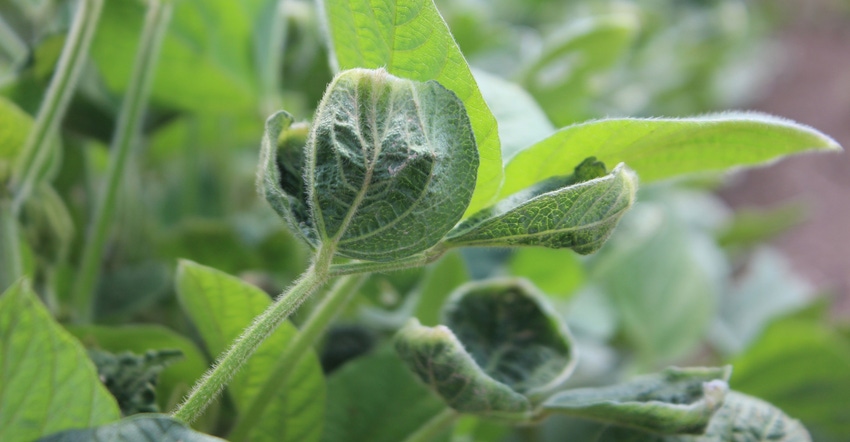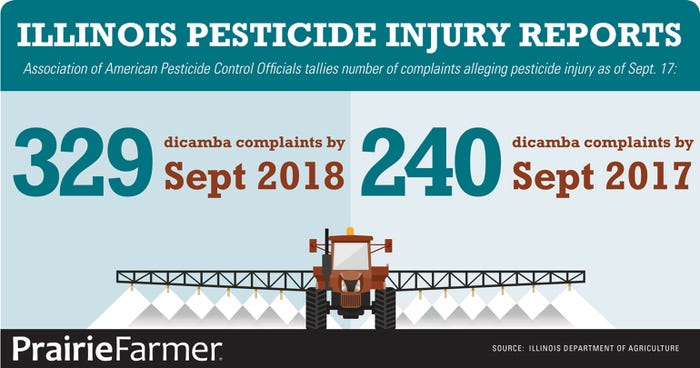
Growers and fertilizer retailers alike are anxiously awaiting delayed changes in the labeling of dicamba by the U.S. Environmental Protection Agency, as well as the results of a lawsuit in the 9th U.S. Circuit Court of Appeals calling for repealing the 2016 label of dicamba-based herbicide XtendiMax.
The uncertain regulatory environment has prompted agronomists to encourage dicamba users to develop a backup plan.
“With as long as the EPA is taking, I think that means they’re trying to work something out. But farmers should have a Plan B in case it doesn’t get worked out,” says Karen Corrigan, agronomist and co-owner of McGillicuddy Corrigan Agronomics.
Aaron Hager, University of Illinois weed science professor, agrees and says that as farmers buy seed for 2019, they should consider non-dicamba options.
“Hypothetically, if the label is thrown out in court, legally, you will not be able spray dicamba,” Hager says. “If you’ve got an issue around weeds that you can no longer control with anything other than dicamba, you may need to switch your varieties to something like a Liberty variety.”
Pesticide complaints on rise
Adding to the pressure, the Illinois Department of Agriculture reports 523 pesticide misuse cases so far this year, with 62% of those filing complaints claiming dicamba as the source of damage. In an average year, prior to 2017, the department fielded from 110 to 130 misuse cases.
“A large portion of the complaints haven’t even been investigated yet. And so if they can’t be investigated while you can see the damage in the field, then I don’t know how hard [IDOA] can really come down on suspected offenders,” Corrigan says.
The Illinois Fertilizer and Chemical Association reports that several of its members have received warning letters about dicamba misuse in 2018.
Hager attributes the recent spike in dicamba misuse cases to the simple fact that more dicamba soybeans were grown and treated with dicamba in 2018 than years prior. Corrigan says there’s a second factor.
“I think last year people were willing to just settle up with their neighbor and let it go,” she adds. “This year, ‘you did it last year, but I’m not going to be as understanding this year’ was more of the attitude, from what I understood.”

Corrigan says many of the complaints are focused in central Illinois, where non-GMO soybeans are a popular pick among growers. She says limiting dicamba spraying to only the fields that need it most can help keep neighbors friendly.
“In 2018, if farmers sprayed dicamba on a quarter of their fields, then we wouldn’t have as much in the atmosphere, and we may not have sustained as much damage as we did,” Corrigan says.
In a survey of Illinois fertilizer applicators, retailers estimate 64% of the soybean acres planted in their territories have the Xtend trait.
Physical or chemical drift?
There are two ways dicamba can drift off-target and into a neighboring field: One is clearly by the fault of the applicator, where the sprayed dicamba catches a wind and physically lands elsewhere, causing major damage to dicot plants that haven’t been genetically modified to resist the herbicide.
All applicators using one of the three formulations of dicamba approved for use in dicamba soybeans were required by the product label to take a class on how to apply it for the 2018 growing year.
The dicamba damage Hager says he’s been seeing on soybeans so far is much more uniform than last year, owing to less physical drift. “The training, I think, was very helpful with that,” he says.
The other way dicamba drifts and causes damage to plants is by volatilization, where temperature picks up a few days after application and the liquid turns into a gas. Applicators can’t be held liable for volatilization, but they are liable for physical drift.
“It’s like a hot potato. The manufacturer passed it off to the applicator,” says Corrigan, adding that in 2018, “everyone who sprayed it had so few days to spray it. They all sprayed it on the same day, and they all hit the wrong weather inversion and caused havoc.”
Volatilized dicamba causes some plants to have stilted growth, but in 2018, the central Illinois region where many dicamba misuse reports are concentrated is also projected to have record-high yields. Corrigan says in drought-stricken South Dakota in 2017, dicamba damage resulted in higher bushel losses.
“The thinking is, if a farmer has 68-bushel soybeans, ‘How can he complain about that?’ Even if, you know, the guy next door has 75 to 80,” Corrigan says. “You can’t prove that [dicamba drift] is what did it.”
About the Author(s)
You May Also Like




